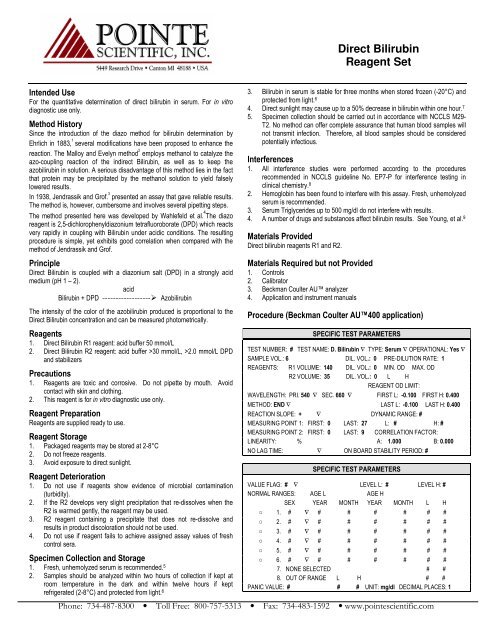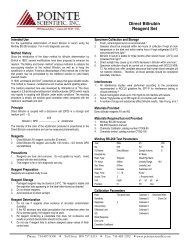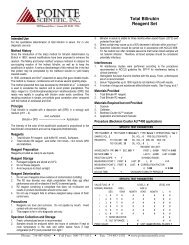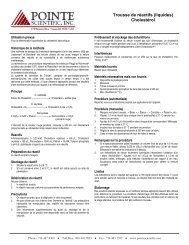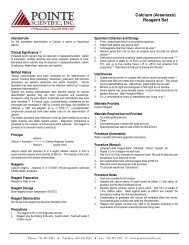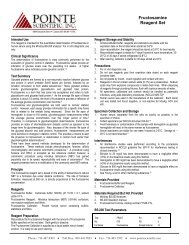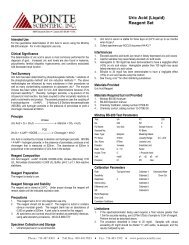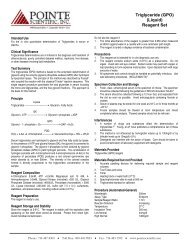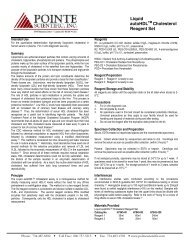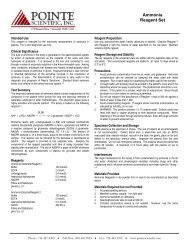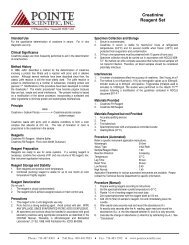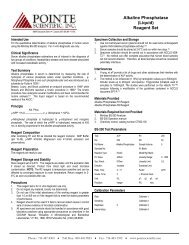OB936-114 - Pointe Scientific, Inc.
OB936-114 - Pointe Scientific, Inc.
OB936-114 - Pointe Scientific, Inc.
You also want an ePaper? Increase the reach of your titles
YUMPU automatically turns print PDFs into web optimized ePapers that Google loves.
Direct BilirubinReagent SetIntended UseFor the quantitative determination of direct bilirubin in serum. For in vitrodiagnostic use only.Method HistorySince the introduction of the diazo method for bilirubin determination byEhrlich in 1883, 1 several modifications have been proposed to enhance thereaction. The Malloy and Evelyn method 2 employs methanol to catalyze theazo-coupling reaction of the indirect Bilirubin, as well as to keep theazobilirubin in solution. A serious disadvantage of this method lies in the factthat protein may be precipitated by the methanol solution to yield falselylowered results.In 1938, Jendrassik and Grof. 3 presented an assay that gave reliable results.The method is, however, cumbersome and involves several pipetting steps.The method presented here was developed by Wahlefeld et al. 4 The diazoreagent is 2,5-dichlorophenyldiazonium tetrafluoroborate (DPD) which reactsvery rapidly in coupling with Bilirubin under acidic conditions. The resultingprocedure is simple, yet exhibits good correlation when compared with themethod of Jendrassik and Grof.PrincipleDirect Bilirubin is coupled with a diazonium salt (DPD) in a strongly acidmedium (pH 1 – 2).acidBilirubin + DPD ------------------ AzobilirubinThe intensity of the color of the azobilirubin produced is proportional to theDirect Bilirubin concentration and can be measured photometrically.3. Bilirubin in serum is stable for three months when stored frozen (-20°C) andprotected from light. 64. Direct sunlight may cause up to a 50% decrease in bilirubin within one hour. 75. Specimen collection should be carried out in accordance with NCCLS M29-T2. No method can offer complete assurance that human blood samples willnot transmit infection. Therefore, all blood samples should be consideredpotentially infectious.Interferences1. All interference studies were performed according to the proceduresrecommended in NCCLS guideline No. EP7-P for interference testing inclinical chemistry. 82. Hemoglobin has been found to interfere with this assay. Fresh, unhemolyzedserum is recommended.3. Serum Triglycerides up to 500 mg/dl do not interfere with results.4. A number of drugs and substances affect bilirubin results. See Young, et al. 9Materials ProvidedDirect bilirubin reagents R1 and R2.Materials Required but not Provided1. Controls2. Calibrator3. Beckman Coulter AU analyzer4. Application and instrument manualsProcedure (Beckman Coulter AU400 application)Reagents1. Direct Bilirubin R1 reagent: acid buffer 50 mmol/L2. Direct Bilirubin R2 reagent: acid buffer >30 mmol/L, >2.0 mmol/L DPDand stabilizersPrecautions1. Reagents are toxic and corrosive. Do not pipette by mouth. Avoidcontact with skin and clothing.2. This reagent is for in vitro diagnostic use only.Reagent PreparationReagents are supplied ready to use.Reagent Storage1. Packaged reagents may be stored at 2-8°C2. Do not freeze reagents.3. Avoid exposure to direct sunlight.Reagent Deterioration1. Do not use if reagents show evidence of microbial contamination(turbidity).2. If the R2 develops very slight precipitation that re-dissolves when theR2 is warmed gently, the reagent may be used.3. R2 reagent containing a precipitate that does not re-dissolve andresults in product discoloration should not be used.4. Do not use if reagent fails to achieve assigned assay values of freshcontrol sera.Specimen Collection and Storage1. Fresh, unhemolyzed serum is recommended. 52. Samples should be analyzed within two hours of collection if kept atroom temperature in the dark and within twelve hours if keptrefrigerated (2-8°C) and protected from light. 6SPECIFIC TEST PARAMETERSTEST NUMBER: # TEST NAME: D. Bilirubin ∇ TYPE: Serum ∇ OPERATIONAL: Yes ∇SAMPLE VOL.: 6 DIL. VOL.: 0 PRE-DILUTION RATE: 1REAGENTS: R1 VOLUME: 140 DIL. VOL.: 0 MIN. OD MAX. ODR2 VOLUME: 35 DIL. VOL.: 0 L HREAGENT OD LIMIT:WAVELENGTH: PRI. 540 ∇ SEC. 660 ∇ FIRST L: -0.100 FIRST H: 0.400METHOD: END ∇ LAST L: -0.100 LAST H: 0.400REACTION SLOPE: + ∇ DYNAMIC RANGE: #MEASURING POINT 1: FIRST: 0 LAST: 27 L: # H: #MEASURING POINT 2: FIRST: 0 LAST: 9 CORRELATION FACTOR:LINEARITY: % A: 1.000 B: 0.000NO LAG TIME: ∇ ON BOARD STABILITY PERIOD: #SPECIFIC TEST PARAMETERSVALUE FLAG: # ∇ LEVEL L: # LEVEL H: #NORMAL RANGES: AGE L AGE HSEX YEAR MONTH YEAR MONTH L H○ 1. # ∇ # # # # # #○ 2. # ∇ # # # # # #○ 3. # ∇ # # # # # #○ 4. # ∇ # # # # # #○ 5. # ∇ # # # # # #○ 6. # ∇ # # # # # #7. NONE SELECTED # #8. OUT OF RANGE L H # #PANIC VALUE: # # # UNIT: mg/dl DECIMAL PLACES: 1Phone: 734-487-8300 • Toll Free: 800-757-5313 • Fax: 734-483-1592 • www.pointescientific.com
Direct BilirubinReagent SetCALIBRATION SPECIFIC PARAMETERSCAL TYPE: AB ∇ FORMULA Y=AX+B ∇ COUNTS: 2 PROCESS: CONC. ∇CAL. NO. OD CONC. FAC/OD-L FAC/OD-HPOINT 1. # # -9999999 9999999POINT 2.POINT 3.POINT 4.POINT 5.POINT 6.POINT 7.1-POINT CAL. POINT: ○ WITH CONC-0MB TYPE FACTOR: CALIBRATION STABILITY PERIOD: ##: User-DefinedThe above reagent parameters are intended to serve as a guide for use with<strong>Pointe</strong> <strong>Scientific</strong>, <strong>Inc</strong>. reagent. The parameters are based on data generatedby <strong>Pointe</strong> <strong>Scientific</strong>, <strong>Inc</strong>. Please note: These parameters should be used inconjunction with your laboratory Quality Control Program for validation.NOTE: For other instrument specific applications please contact <strong>Pointe</strong><strong>Scientific</strong>, <strong>Inc</strong>. Technical Service Department at 1-800-445-9853Pediatric VolumesFor pediatric samples with bilirubin over 3.0 mg/dl, run a 1:1 dilution withsaline. Multiply result by two.CalibrationFollow instrument application instructions for calibration. Refer to instrumentmanual instructions for calibration procedures and frequency. It isrecommended that each laboratory determine its own frequency ofcalibration.Quality ControlThe validity of the reaction should be monitored by use of the control serawith known normal and abnormal direct bilirubin values. These controlsshould be run at least with every working shift in which direct bilirubin assaysare performed. It is recommended that each laboratory establish its ownfrequency of control determination.Limitations1. Samples with values above 10 mg/dl must be diluted 1:1 with isotonic saline,re-assayed and the final answer multiplied by two.2. Hemoglobin has been found to interfere with this assay.3. Triglycerides up to 500 mg/dl do not interfere with results.Performance1. Assay Range: 0.0 - 10.0 mg/dl2. Comparison: A comparison study performed between the Beckman CoulterAU400 and Roche Hitachi 717 using this method resulted in a correlationcoefficient of r = 0.950 with a regression equation of y=1.092x+0.10.(n = 38, range 0.0 – 1.3 mg/dl)3. Precision:Within - day precision study was performed using three levels of material.Between - day precision study was performed using two levels of controlmaterial with 2 runs per day and 2 replicates per run.Within Day (N=20) Day to DayMean S.D. C.V.% Mean S.D C.V.%0.7 0.00 0.0 0.7 0.05 7.14.2 0.15 3.6 4.6 0.30 6.57.2 0.11 1.5Precision and Linearity studies were performed following modifications of CLSIProtocols EP5 and EP6 11 using a Beckman Coulter AU400 analyzerReferences1. Ehrlich, P., Charite Ann. 8:140(1883).2. Malloy, H.T., Evelyn, K.A., J. Biol. Chem. 119:481 (1937).3. Jendrassik, L., Grof, P., Biochem. Zeitschr. 297:81 (1938).4. Wahlefeld AW, et al. Scand J Clin Lab Invest. 29 Supplement 126(1972).5. Michaelsson, M. Scand. J. Clin. Lab. Invest (Suppl. 49) 13:1 (1961)6. Martinek, R.G., Clin. Chem. Acta 13:161 (1966).7. Tietz, N.W. Fundamentals of Clinical Chemistry, Philadelphia, W.B.Saunders, P. 1028 (1976).8. NCCLS document, “National Evaluation Protocols for Interference Testing”,Evaluation Protocol Number 7, Vol. 4, No. 8, (June 1984).9. Young, D.S., Effects of Preanalytical Variables on Clinical Laboratory Tests,Washington DC, AACC Press, (1997)10. Gambino, S.R., et al, Bilirubin Assay (Revised), Commission on ContinuingEducation, Am. Soc. of Clin. Path., Chicago, (1968).11. CLSI protocols EP5-A2, Vol. 24 No. 25, 2 nd Ed, (2004) and CLSI EP6-A, Vol.23 No. 16 (2003)CalculationsAbs. = AbsorbanceUnk. = UnknownCal. = CalibratorAbs. Unk. – Abs. Unk. Blank x Conc. of Cal. (mg/dl) = Direct Bilirubin (mg/dl)Abs. Cal. – Abs. Cal. BlankSample: If Abs. of Unknown = 0.35, Abs. of Unknown Blank = 0.01, Abs. ofCalibrator 0.25, Abs. of Calibrator Blank = 0.01, Concentration of Calibrator =4.0 mg/dlThen: 0.35 – 0.01 x 4 = 0.34 x 4 = 5.7 mg/dl0.25 – 0.01 0.24Expected Values (Direct) 7,10Adults and infants (over one month): 0 – 0.5 mg/dlIt is strongly recommended that each laboratory establish its own normalrange.Manufactured by <strong>Pointe</strong> <strong>Scientific</strong>, <strong>Inc</strong>.5449 Research Drive, Canton, MI 48188European Authorized Representative:Obelis s.a.Boulevard Général Wahis 531030 Brussels, BELGIUMTel: (32)2.732.59.54 Fax:(32)2.732.60.03Rev. 02/13 P803-<strong>OB936</strong>-01email: mail@obelis.net


